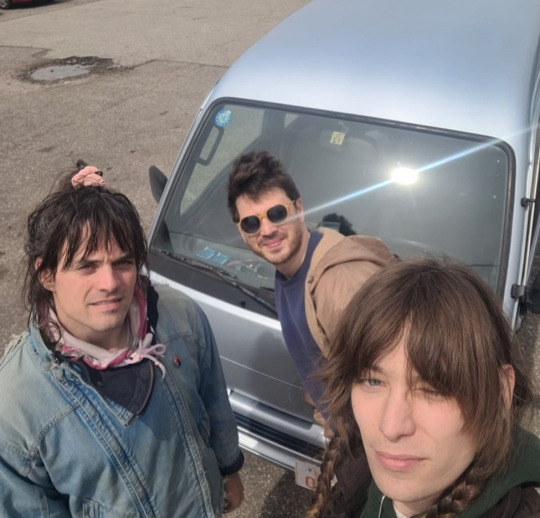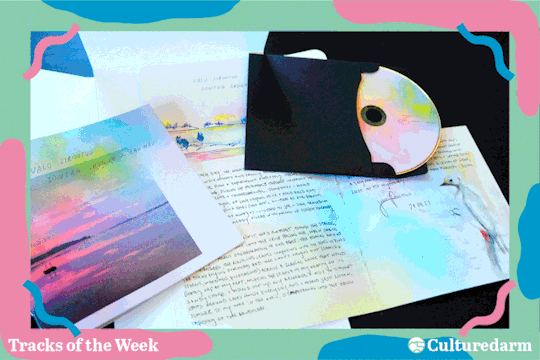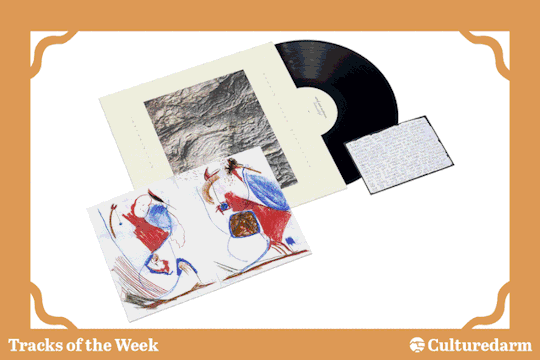#Mitch Stahlmann
Text
Signal Quest — Hypermyth (Orange Milk

Hypermyth is audio-only virtual reality. It’s an immersive, open-ended journey through a strange and fascinating world, an environment that beckons exploration. The Signal Quest trio have hewn this uncanny landscape using analog and digital implements, crafting a craggy geology replete with crystalline, multi-hued flora. Their music reflects a fascination with 1990s computer games, specifically the unique mythology of Myst. Unlike the nascent open-world gaming experience of decades past, Signal Quest’s music flows free of technological limitation. There’s no waiting between scenes for the CD-ROM to spin up. Cole Pulice, Lynn Avery and Mitch Stahlmann create a seamless stream of sound, with breathtaking high-resolution imagery limited only by the imagination of your mind’s eye.
Pulice, Avery and Stahlmann are long-time friends and collaborators, coming from Minneapolis but now calling Oakland, California home. They’ve added their unique talents to each others’ records, such as on Avery’s Carpet Cocoon, released under the name Iceblink. That record’s warm new age vibe took on a multitude of dimensions when augmented by the alien ECM stylings of Pulice’s saxophone and Stahlmann’s flute. Equally lush but veering into more abstract territory was Avery and Pulice’s collaborative work To Live & Die in Space & Time. Its moody vibe unfurled delicately but bristled with layers of electronics. Years before those two records arrived, the trio was finding their footing, experimenting under the name LCM and creating hallucinatory sound worlds that set the stage for even bolder adventures to come.
Hypermyth is indeed Pulice, Avery, and Stahlmann’s most intrepid venture thus far. The textures are deeper, with larger cracks and crevices within which to get lost. Tones often twist and bend in many directions, like light refracting through glass. Musique concrète techniques adhere to the trio’s new age and ambient signifiers, conjuring fractalized patterns that glitch and writhe beneath Pulice and Stahlmann’s breath-modulated melodies. At times these more arcane sonorities lie beneath the surface of the trio’s soundscapes, such as on album opener “Sparkling Node Network.” In other moments, like on the ultra-short piece “moonVR” or the more drawn out “mailer-daemon.exe,” the abstract shapes infect and subsume the more delicate passages, withering and distorting the harmonies.
The musicians often find a delicate balance between pure beauty and sheer experimentation, and gentleness. Pulice, Avery, and Stahlmann have immersed themselves in a unique, unexplored sonic world, but haven’t lost themselves completely in its knotty, rough-textured depths.
Bryon Hayes
#signal quest#hypermyth#orange milk#bryon hayes#albumreview#dusted magazine#Cole Pulice#Lynn Avery#Mitch Stahlmann#electronics#musique concrete#myst
2 notes
·
View notes
Photo

• mitch stahlmann
• into the wish
• bit.ly/mS-iTw
0 notes
Text
#moreoncoffeee
granie sb samemu dj seta do kawy to serio jest jedna z moich ulubionych czynności w życiu. Ćwiczę sobie przed popołudniem, zagram tam:
Mitch Stahlmann - Petrified Cloud
ryong & victor espasandín - meaningless duet
nudo - convertido
YNO - oora
Holly Waxwing - Softcorners
Señor Service - Morning Walk
rec - summer adventure
goo age - ▒░▓
Metoronori - Pearl- Ptyx
Moskitoo - Who Lives in the Skin Burn
dorencore - chaos + nickk
NUG - Heat
Kenji & 川 - good sleep
crimeboys - sex and drugs
Andriy Kostyukov - shelest dub pt.1
Chickenmilk dot com - 23 jailbreak gazadrenaline (bino drummed)
Ulla & Ultrafog - lame mart
shinetiac - Star Frog Dilla
galen tipton - touch w- Holly Waxwing and Giant Claw
J and the woolen stars - knees
2 notes
·
View notes
Text
Noah Ophoven-Baldwin
[Time pieces (and I’ll go to bed at noon)]

Release date: June 02, 2023
Catalog no. zappak-004
https://zappak.bandcamp.com/album/time-pieces-and-ill-go-to-bed-at-noon
[Tracklist]
1. Buzzing and humming [01:12]
2. Gnomon [10:40]
3. This universe [13:40]
4. More of the tree [18:18]
Excerpt: https://soundcloud.com/zappak/zappak-004
Noah Ophoven-Baldwin: Cornet, harmonium, metronome, and field recordings
Mitch Stahlmann: Flute (Track 2)
Tracks 1, 3, & 4 recorded and mixed by Noah Ophoven-Baldwin
Track 2 recorded at Aura Vortex by Matt Olson
Mastered by Zhu Wenbo
Photo by Noah Ophoven-Baldwin at Harbor Park Beach in Port Wing, Wisconsin.
—–
This is the commemorative first solo album by Noah Ophoven-Baldwin, a Minneapolis-based multi-instrumentalist and a member of the group "Realtree". The theme of this work is "time and/or clock". By mixing acoustic instruments' sounds and a periodic metronome sound, Baldwin tried to cross the boundaries of an instrumental performance and a conceptual sound art.
A cornet and a harmonium make organic texture (and Mitch Stahlmann joined with a flute on track 2). On the other hand, a metronome keeps repeating solid and short sounds like hitting a stake. Instrumental sounds like he played in a room while relaxing and the sharp metronome sounds seem to be in contrast, however, the careful arrangement of the field-recorded sounds creates a wonderfully beautiful unity as a whole.
アメリカはミネアポリス在住のマルチ奏者であり、音楽グループ"Realtree"メンバーのNoah Ophoven-Baldwinによる、記念すべき初のソロ・アルバム。本作は「時/時計」をテーマとしており、Baldwinはメトロノームの周期的な音とアコースティック楽器の音を組み合わせることによって、演奏とコンセプチュアルなサウンド・アートを横断させようとした。
コルネットやハルモニウムは有機的なテクスチャーを生み出し(2曲目ではMitch Stahlmannがフルートで参加)、いっぽうのメトロノームは杭を打ち付けるかのように鋭利で短い音を反復させる。部屋でリラックスして演奏されたような器楽音と鋭利なメトロノームの音は、対極のようなコントラストがあるかのようでいて、フィールド・レコーディングされた音の注意深い配置によって、見事に美しいまとまりを見せている。
—–
Noah Ophoven-Baldwin

Noah Ophoven-Baldwin is an American composer, cornetist, and improviser currently living in so-called Minneapolis, Minnesota. His work collages field recordings, metronome and cornet. Noah plays and writes music for the group Realtree, with releases on Public Eyesore and Zoomin' Night, and runs the CD label All Sky.
http://musicallaround.us/
【Reviews】
Vital Weekly:
https://zappak.tumblr.com/post/720636478816927744
0 notes
Photo

(▶︎ Scry | Cole Puliceから)
Scry by Cole Pulice
Cole Pulice is a composer, saxophonist and electroacoustic musician from Oakland-via-Minneapolis. Following their debut album "Gloam" and two duo collaborations with Lynn Avery and Nat Harvie, Cole Pulice returns with their sophomore album "Scry". The sound is deeply contemporary, incorporating saxophone/wind synth with live signal processing and modern electronics/software. It drifts between electroacoustic experimentalism and more traditional forms of song-like beauty, casting a wide sonic net that highlights Pulice’s versatility and creativity as both an improviser and composer.
From Cole:
"Scry is a collection of musics exploring fragmentary or gradient states of liminality – recursive spirals of worlds hidden within worlds, dreams within dreams, sensations of time, and the notion of the past, present, and future all occupying a single point.
It’s a record that, for me, resonates strongly with this sort of “between-ness:” it began in Minneapolis, and was finished in Oakland, bridging pre-pandemic life with the “new normal” of current times; being genderqueer and navigating the spaces between and outside of the masculine and feminine binary; wandering through a musical interchange station that is interconnects improvisation, “song,” and collage experiments . . . multidimensional yet woven together by similar aesthetic threads.
Whereas my previous record, Gloam, was mostly a series of compositions for a very specific electroacoustic setup, Scry utilizes a series of different hardware/software frameworks and apparatus. Or, to think of it in another way: Gloam was like looking through a kaleidoscope (each turn of the handle giving a different abstract perspective of the same bits of gemstone); Scry is more like a stained-glass crystal ball (a singular sculpture, with each fragment somehow offering an ephemeral glimpse into another world or dimension).
Scry is deeply indebted to the electroacoustic works of Pauline Oliveros, David Behrman, Marion Brown, Maggi Payne, Harold Budd, and Jon Hassell - all of whom explored, in their own ways, the interconnectivity between acoustic instruments, interactive electronic signal processing, and improvisation - the crux of ‘Scry’s DNA. To this end: virtually all of the signal processing on ‘Scry’ is done live as I play saxophone/wind synth, either through a hardware setup that I control with my feet as I play, or through software instruments I build which respond live to what I’m playing. Often, both software and hardware processes are being used simultaneously.
"To scry" defines the practice of foretelling the future through gazing into a crystal ball or other reflective surfaces. There's a lot to say here regarding the mix of temporalities, timelines, states of being, and so forth, but I mostly just have to give a special thanks to glass artist, composer, and dear friend Sadie Robison. The arcane aesthetics of her technicolor stained glass sculptures were a major influence on the themes of Scry 🧡"
—Cole Pulice クレジット2022年9月30日リリース
Recorded between 2019—2022 in:
Minneapolis, Minnesota
Seward, Ventura Village, 8vB Studio
Oakland, California
West Oakland, Oakland Music Complex,
Paul Dresher Ensemble Studios,
Reinhardt Redwoods Regional Park
Lynn Avery: Live signal processing on "Moon Gate Rune," clarinet on "Scry"
Charlie Bruber: Electric bass on "Astral Cowpoke," double bass on "City in a City"
Mitch Stahlmann: Clarinet, Lou Harrison Digital Gamelan, Sampling on "Scry"
Mixed by Lynn Avery & Cole Pulice
Mastered by Angel Marcloid at Angel Hair Studios
Art & Design by Steve Rosborough
0 notes
Photo

Mitch Stahlmann summons sacred incantations on the flute for the Polish label Mondoj, Tekla Peterson strives for ecstatic release through eighties pop forms on Geographic North, and Sontag Shogun and Lau Nau send missives from the halcyon summer of 2019 and the Finnish island of Kimitoön. Tracks by Arca, Susanna, East Portal, Yama Warashi, Ohyung, Ethel Cain, and Emilie Levienaise-Farrouch complete the roundup of best new music.
https://culturedarm.com/tracks-of-the-week-09-04-22/
#music#new music#sontag shogun#lau nau#spencer zahn#east portal#ohyung#tekla peterson#yung lean#fka twigs#yama warashi#mitch stahlmann#more eaze#claire rousay#s. carey#loraine james#whatever the weather#susanna#alternative#experimental#ambient#field recordings#post-rock#electronic#avant garde#jazz#folk#fifth world#dub#techno
0 notes
Video
vimeo
For her exhibition Tree Talk, María Elena González invites composers John Ivers and Marc Zollinger to premier original scores generated from her birch tree rubbings. Tree #3, performed by Illuminated Grey Ensemble Composed by Marc Zollinger “ …light is colourless in the sense in which numbers are colourless…whatever looks luminous does not look grey. Everything grey looks as though it is being illuminated… For the fact that we cannot conceive of something “glowing grey” belongs neither to the physics nor to the psychology of colour…of two places in my surroundings which I see in one sense as being the same colour, in another sense, the one can seem to me white and the other grey. To me in one context this colour is white in a poor light, in another it is grey in good light. These are propositions about the concepts ‘white’ and ‘grey’ –L. Wittgenstein, from Remarks on Colour While investigating Maria Elena’s process and hearing the sounds of the tree through the player piano, I was inspired to think of other ways of hearing the tree. I hear it as both vertical and linear time. I arranged the tree on the score to represent a multiplicity of time through the process of layering in collage. The lines in the tree are vertical and horizontal, and sometimes the tree is upside down. I structured it in three continuous movements, as in a triptych. I also tried to hear and represent the color of the tree, which is a white-grey. The electronics to me represent this color, and the instruments provide support and contrast to it, creating both a resulting movement and stasis. The electronics use a time-strech of the recording of the player piano, and the musicians use notes and passages coming from the same source material, as material for improvisation/composition. I would like to thank Stephanie Hanor, Maria Elena Gonzalez, and all the musicians for helping to make this event possible. Curt Brown - Electronics Golnaz Shariatzadeh – Violin Mitch Stahlmann - Flute Rodolfo Cordova-Lebron - Voice Tim Russell - Percussion Tony Gennaro - Percussion Lee Hodel - Upright Bass Jake Parker Scott - Alto Sax Marc Zollinger - Conductor
0 notes
Photo

https://www.facebook.com/events/419117355205747/
Sediment
Swiss percussionist and sound artist Simon Berz has a multitude of projects and collaborations under his belt. Performing as Sediment, he plays a lithophone made from ancient stones, amplified and manipulated with electronic effects. By scratching, stroking, and striking the stones with different sticks and materials, he creates a dense soundscape and a unique performance.
http://www.simonberz.ch/index.php?%2Fwork%2Flithophon%2F
dustsceawung
ASMR chamber noise on flute, cornet, and viola.
Miriam Karraker, Mitch Stahlmann, and Noah Ophoven-Baldwin perform with breathtaking restraint, exposing the deepest sonic textures of their instruments. One might say their sound is both anti-music and anti-noise, but operates at the level of pure sensory phenomena. One might also say it causes a tingly sensation.
Cole Pulice & Jonathan Kaiser
droning tones on saxophone and cello.
post-harmonic / pre-historic
0 notes
Photo

Janek Schaefer and William Basinski reweave a piano passage from their collective archive in a meditation on memory, Vasco Trilla explores improvisation as a form of acoustic mask, Astrid Øster Mortensen issues windswept missives from the Gothenburg archipelago, and Kalia Vandever, Mitch Stahlmann, Daniel Villarreal, Arooj Aftab, Rosalía, Hinako Omori, and Ecko Bazz complete the best new tracks.
https://culturedarm.com/tracks-of-the-week-19-03-22/
#music#new music#astrid Øster mortensen#ecko bazz#mitch stahlmann#william basinski#janek schaefer#rosalía#vasco trilla#daniel villarreal#azu tiwaline#labdi#syd#lucky daye#isik kural#spefy#laura cannell#ambient#drone#experimental#soul#funk#jazz#avant garde#electronic#field recording#minimal#gqom#grime#culture
0 notes